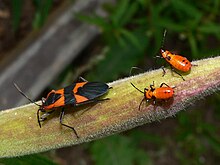Large milkweed bug
| Large milkweed bug | |
|---|---|
 |
|
| Scientific classification | |
| Kingdom: | Animalia |
| Phylum: | Arthropoda |
| Class: | Insecta |
| Order: | Hemiptera |
| Family: | Lygaeidae |
| Genus: | Oncopeltus |
| Species: | O. fasciatus |
| Binomial name | |
|
Oncopeltus fasciatus (Dallas, 1852) |
|
Oncopeltus fasciatus, known as the large milkweed bug, is a medium-sized hemipteran (true bug) of the family Lygaeidae. It is distributed throughout North America. It ranges from Central America through Mexico and the Caribbean to southern areas in Canada.Costa Rica represents this insects southern limit. It inhabits disturbed areas, roadsides and open pastures. Due to this widespread geographic distribution this insect exhibits varying life history trade-offs depending on the population location.
Adults can range from 10–18 mm in length and have a red/orange and black X-shaped pattern on their wings underneath the triangle that is typical to hemipterans. This feature makes the bug easily seen, acting as a aposomatic warning to predators of distastefulness. O. fasciatus exhibits müllerian mimicry and is noxious to predators. The ventral side of the fourth abdominal segment bears a black band in the male and two black spots in the female. Juveniles are born mostly red with black antennae and a few black spots, throughout growth the black spots are developed as well as wing pads. Eggs of this insect are bright orange and easily detectable.
This large milkweed bug is a hemimetabolous insect, meaning it grows in stages called instars and goes through incomplete metamorphisis exhibiting small changes throughout development such as coloration changes, development of wings and genitalia. O. fasciatus begins as an egg and experiences 4 nymphal stages over 28–30 days before moulting to adulthood. Females become sexually receptive within a few days of adulthood. Geographic location has a large effect on egg production rate and clutch size, although the intrinsic increase in reproduction depends on what the individual is acclimated to. For example, two close populations (60 km apart) residing on a sharp incline have differing optimal reproduction temperatures where the cooler (higher) adapted populations is at 23 °C and the warmer (lower) population is adapted to 27 °C. Highest clutch size occurs in Puerto Rico, Florida and Texas populations at 30-50 eggs per clutch. Lowest clutch size was found in California at 25-30 eggs per clutch. Iowa and Maryland (northern populations) exhibited a clutch size in between the two extremes from 25-35 eggs per clutch.
...
Wikipedia
